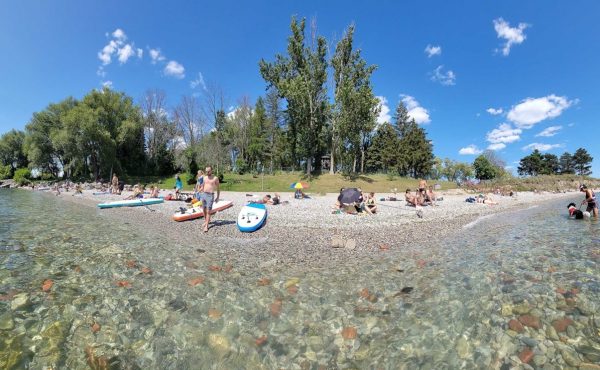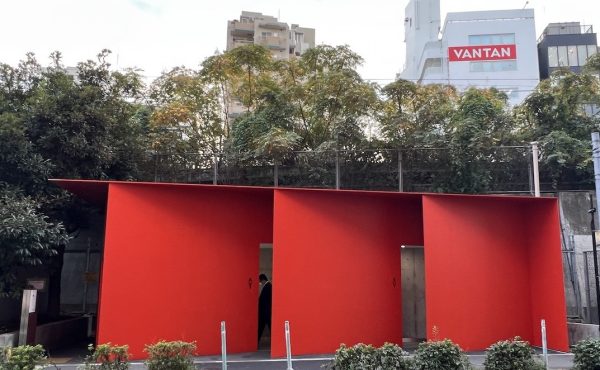
Over the weekend the National Post ran a story collecting the thoughts of nine different architects and planners (including me, a pretend architect/planner). You can read that story here. Below is the longer text of what I proposed. What are you thoughts on what should be done at the site?
The centrepiece of a revitalized Ontario Place would be the Cinesphere and the five interconnected pods suspended over the lake. These buildings, designed by Toronto architect Eberhard Zeidler, are absolutely unique modern heritage buildings, unlike anything in the world. Toronto would be foolish to demolish them. Around the perimeter of these buildings let Waterfront Toronto establish a meandering main street, following the old Ontario Place promenades, and build a low-rise but dense residential community with retail for shops, restaurants and bars along the sidewalk. Public parkland would be continuous by the lakeside and weave throughout, connecting to the canals. Imagine 10,000-20,000 new residents here and a series of bridges over Lake Shore Blvd connecting to the new 30,000-40,000 strong Liberty Village and Fork York neighbourhoods. Ontario place suddenly becomes the centre of all this human action and new uses for the pods and sphere become immediately apparent. These folks might even like a local movie theatre.




9 comments
Make it accessible, welcoming, fun for couples and for families, comfortable for tourists, and make it about Ontario, past present and future.
Dominion Modern have been looking for a home for quite some time now (and I believe they’re now considering decamping to Winnipeg). I’ve often thought Ontario Place would be a great fit, aesthetically speaking, for a gallery & archive of modern Canadian design and architecture.
Donald> No single people?
Spadina> Ya!
Needs pictures. I’m hoping whatever is chosen moves from treating Lakeshore Blvd like an expressway barrier complete with pedestrian bridges to traffic calming making for better level crossings for pedestrians. It can be a true urban boulevard with buildings, sidewalks and people. We already have an expressway barrier just to the north and as for the auto race, temporary bridges are used for the short duration of the race in other parts of the Ex grounds.
Try to keep the chains and franchises out or at least last on the list, more independent pubs and stores. Try for more year-round entertainment or amusements, indoor waterpark for one. Hotel. Hide the parking lots behind a hotel or put in a garage to hide the cars.
Random thoughts:
Definitely huge potential in the Cinesphere and pods. No brainer.
I can appreciate OP as a new, local neighbourhood. But regardless of what happens in the centre, if OP is to be a destination for others to visit/experience/enjoy, it seems to me that, among other functions, OP needs to provide some sense of an ‘urban oasis’ – an inviting bridge between the experience of the urban and the natural. So while the continuous, waterfront parkland would be crucial to this end, I could imagine both a ‘looking out’ and ‘looking in’ experience – so allow for small, independent cafes/bars/restos along the waterfront (looking out), distinct from the services offered within the new neighbourhood (looking in).
Basically, I think as long as OP becomes clear about what it’s doing and who it’s for, we’ll have come a long way. Though too, I think it’s future should be considered in tandem with that of Exhibition Place.
This was my favourite suggestion when I read the original article. I like the residential component, bringing year round life to the area rather than making it a theme park. I know that people have issues with the Ward Islanders, but I like their little car free neighbourhood, with sidewalks instead of roads separating the properties. It could be interesting to use that model of cottagy small scale development as a component of new residential in places like the Portlands (or Ontario Place), accentuated with townhouses or apartment to bring greater density.
Maybe even keep what one can of the existing restaurant pavilions. (Or if they can’t be maintained in situ, reuse them elsewhere. They seem sufficiently “portable”.)
In the June 2002 issue of Toronto Life, in a feature on reinventing the waterfront, Artist Charles Pachter suggested turning Ontario Place into Artist/Artisan Studios and Shops (I’m guessing something like Harbourfront Centre but with more studio space). Considering the commonplace difficulty most artists have finding affordable studio space in big cities, I love the idea